pistol
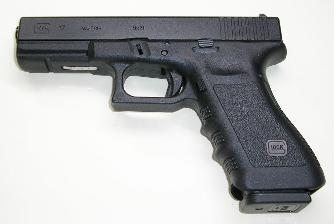
The word "pistol" is often synonymous with the word "handgun". Some handgun experts make a technical distinction that views pistols as a subset of handguns. Sometimes in usage, the term "pistol" refers to a handgun having one chamber integral with the barrel, making pistols distinct from the other main type of handgun, the revolver, which has a revolving cylinder containing multiple chambers. The pistol originates in the 16th century, when early handguns were produced in Europe. The English word was introduced in ca. 1570 from the Middle French pistolet (ca. 1550).The etymology of the French word pistolet is unclear. It may be from a Czech word for early hand cannons, píšťala "flute", or alternatively from Italian pistolese, after Pistoia, a city renowned for Renaissance-era gunsmithing, where hand-held guns (designed to be fired from horseback) were first produced in the 1540s.
Sub-Machine gun
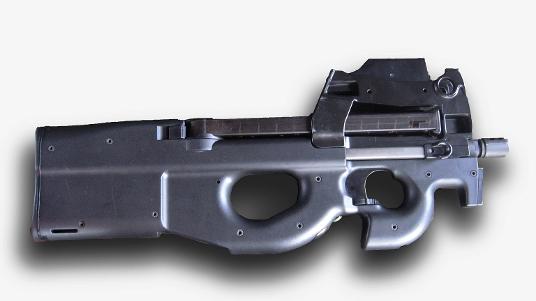
A submachine gun (SMG) is an air-cooled, magazine-fed, automatic carbine designed to fire pistol cartridges. The term "submachine gun" was coined by John T. Thompson, the inventor of the Thompson submachine gun.[1] The submachine gun was developed during World War I (1914–1918). At its zenith in World War II (1939–1945), millions of SMGs were made. Today, submachine guns have been largely replaced by assault rifles, which have a greater effective range and are capable of penetrating ballistic helmets and body armor used by modern infantrymen.[2] However, submachine guns are still widely used by police and military special forces, who value the SMG's reduced recoil and noise signature, especially when suppressed. Its reduced risk of overpenetration is also a particularly valuable trait to police forces. In the early 20th century, experimental machine pistols were made by converting pistols such as the Luger P-08 and Mauser C96 from semiautomatic to full-automatic operation and adding detachable stocks. Carbine-type automatic weapons firing pistol rounds were developed during the latter stages of World War I by Italy, Germany and the United States. Their improved firepower offered an advantage in trench warfare.[8] In 1915, the Italians introduced the Villar-Perosa aircraft machine gun. It fired pistol-caliber 9mm Glisenti ammunition, but was not a true submachine gun, as it was originally designed as a mounted weapon. This odd design was then modified into the Beretta OVP carbine-type submachine gun, which then evolved into the Beretta Model 1918 after the end of World War I. Both the Beretta OVP and the Model 1918 had a traditional wooden stock, a 25-round top-fed box magazine, and had a cyclic rate of fire of 900 rounds per minute.
Assault Rifle
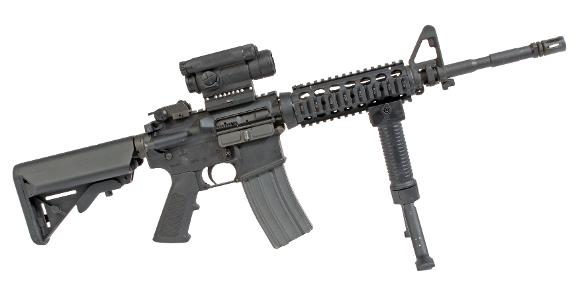
An assault rifle is a selective fire rifle that uses an intermediate cartridge and a detachable magazine. Assault rifles are currently the standard service rifles in most modern armies. Examples of assault rifles include the StG 44,AK-47 and the M16 rifle. The Germans were the first to pioneer the assault rifle concept, during World War II, based upon research that showed that most firefights happen within 400 meters and that contemporary rifles were over-powered for most small arms combat. They sought to develop a select-fire intermediate powered rifle combining the firepower of a submachine gun with the accuracy and range of a rifle.This was done by shortening the standard 7.92x57mm cartridge to 7.92x33mm and giving it a lighter 125 grain bullet, that limited range but allowed for more controllable automatic fire. The term assault rifle is a non-direct translation of the German word Sturmgewehr (literally "storm rifle", "storm" as in "military assault"). The name was coined by Adolf Hitler as a new name for the Maschinenpistole 43,subsequently known as the Sturmgewehr 44, the firearm generally considered the first assault rifle that served to popularize the concept and form the basis for today's modern assault rifles. The translation assault rifle gradually became the common term for similar firearms sharing the same technical definition as the StG 44. In a strict definition, a firearm must have at least the following characteristics to be considered an assault rifle.
Machine Gun
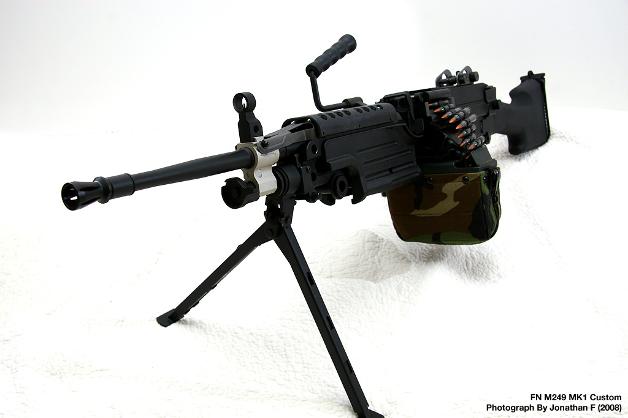
A machine gun is a fully automatic mounted or portable firearm, usually designed to fire bullets in quick succession from an ammunition belt or magazine, typically at a rate of three to eighteen hundred rounds per minute. A machine gun is often portable to a certain degree, but is generally used when attached to a mount or fired from the ground on a bipod or tripod, and generally fires a rifle cartridge and is capable of sustained fire Unlike semi-automatic firearms, which require one trigger pull per round fired, a machine gun is designed to fire for as long as the trigger is held down. Nowadays the term is restricted to relatively heavy weapons fired from some sort of support rather than hand-held, able to provide continuous or frequent bursts of automatic fire for as long as ammunition lasts. Machine guns are normally used against unprotected or lightly protected personnel, or to provide suppressive fire. Some machine guns have in practice sustained fire almost continuously for hours; other automatic weapons overheat after less than a minute of use. Because they become very hot, practically all machine guns fire from an open bolt, to permit air cooling from the breech between bursts. They also have either a barrel cooling system, or removable barrels which allow a hot barrel to be replaced.
Sniper Rifle
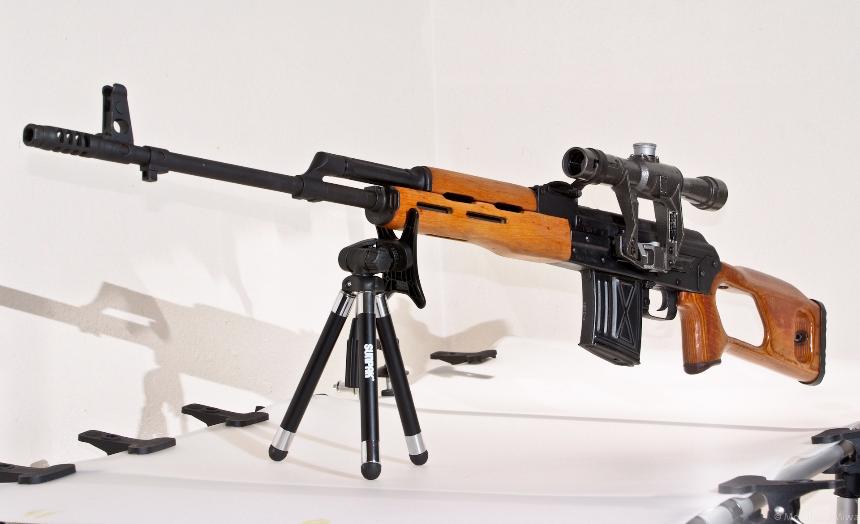
In military and law enforcement terminology, a sniper rifle is a precision-rifle used to ensure more accurate placement of bullets at longer ranges than other small arms. It is a common misconception that any scoped rifle is a sniper rifle, and while certain long guns are more suited for the application than others, it is the act of using a weapon strategically as a sniper that designates it as such. A typical sniper rifle is built for optimal levels of accuracy, fitted with a telescopic sight and chambered for a military centerfire cartridge. The term is often used in the media to describe any type of accurized firearm fitted with a telescopic sight that is employed against human targets, although "sniping rifle" or "sniper's rifle" is the technically correct term for such a rifle. The Whitworth rifle was arguably the first long-range sniper rifle in the world. Designed by Sir Joseph Whitworth, a prominent British engineer, it used twisted hexagonal barrels instead of traditional round rifled barrels, which meant that the projectile did not have to bite into grooves as was done with conventional rifling. His rifle was far more accurate than the Pattern 1853 Enfield, which had shown some weaknesses during the recent Crimean War. At trials in 1857 which tested the accuracy and range of both weapons, Whitworth's design outperformed the Enfield at a rate of about three to one. The Whitworth rifle was able to hit the target at a range of 2,000 yards, whereas the Enfield could only manage it at a distance of 1,400 yards.
